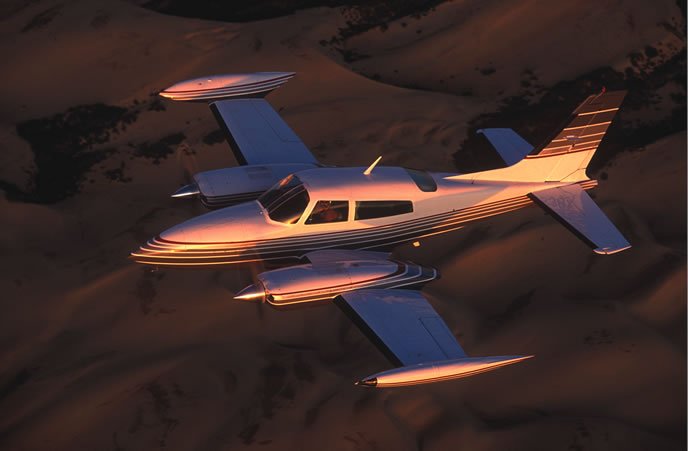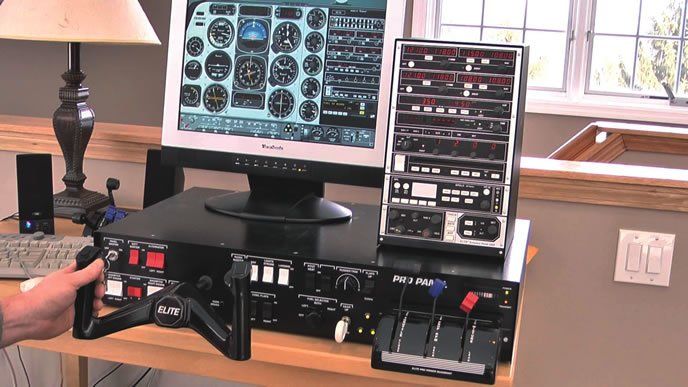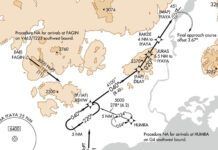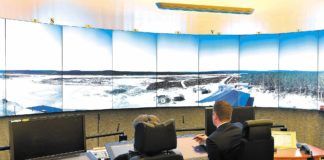Previously, I’ve described a practice of regular recurrent training in two articles: “Proficiency in Pieces,” in the July 2007 issue of IFR, and its follow-up, “Proficiency in Pieces 2.0” in April, 2012. This program is a simulator-based recurrent training program in which you specify the minimums to which you want to train, and then design a specific training program tailored to your exact requirements, while assuring that your target performance meets or exceeds that prescribed in the regulations for your flying—Part 91 or even Part 135.

I’m now writing about Proficiency in Pieces for a third time, partly to re-emphasize the idea. It has worked very well for me and others I know. More importantly, I want to fully stress what I have found to be, for me, a cornerstone of it that is missing in articles by others about their approach to personal sim training—the use of a qualified instructor to conduct the training.
The Setup
When the Elite Flight Simulator came to market near the end of the last millennium, I made a mad dash to buy one. After using keyboard controls for a few practice hours, I added a control column, rudder pedals and a twin-engine quadrant to augment my twin-Cessna recurrent training.
I was excited about this new world of training devices, seeing them as a way to augment or even eclipse my semiannual trips for formal simulator-based recurrent training. But before I could actually use the Elite to train, I had to set up, troubleshoot, calibrate and iterate. The desktop control column and throttle quadrant were awkward to use. The rudder pedals, for engine out work, were a joke.
Nonetheless, after a few weeks of technical futzing, I was finally set to use my home sim to do some serious procedures training. I knew it would be a long way from the real thing but at least I could brush up on procedures at will or reshoot an approach that in real life needed improvement.
However, far worse than contending with ongoing technical glitches, which I’m sure are a far-diminished pain today, I found, for the first time in my career, that I could not get along with my instructor.
Long before he pulled an engine on the runway or ten feet off the ground, or plugged the pitot-tube drain for a low-viz instrument takeoff, or threw multiple gyro failures at me in the soup that left me on partial panel, I always knew that they were coming. He just never surprised me.
He also was a horrible disciplinarian. When I made a mistake he let me drop my guard and just start a different approach instead of going back and redoing the same one until I got it right. When it came to debriefing a recent actual flight, one in which I failed to raise the gear on a missed approach, dialed in a wrong fix or landed long, he had no ability to discuss my mistakes with me and recognize and draw out their root causes for analysis.
I had once made a living in school as a CFII and an advanced and instrument ground-school instructor so I well knew the guy I was using for my home instruction was a real loser. So… I fired him, uh, myself. I was simply not up to the job of counseling, disciplining, or teaching myself. In fact, very few of us are.
I called the local FAA Designated Examiner who is the best flight instructor and still the most enthusiastic pilot I’ve ever known. “Joel, I’ve got this PC-based, home sim,” I said. “Technically it’s a decent device, but as my own instructor I’m a complete failure. I’ve put $2,500 into this thing. How about if I give it to you, forever, and I pay you to instruct me in it?”
Over the next two years Joel invested a lot more into it. Three years after that he purchased a far more sophisticated simulator. His equipment investment is now in excess of $100,000. For the last seven years I’ve been flying the sim with Joel the first Saturday of every month from 7:30 AM to 9:30 or 10:00 AM depending on how much ground school we end up doing.
That’s done a terrific job of keeping my skills up, while in fact building new ones. But I gradually found I needed an even tighter focus, specifically tailored to my flying.

The Problem
I fly a turbo Cessna 310R with a mostly-glass cockpit that’s certified for flight into known icing (FIKI). It’s an airplane with a wide enough operating envelope, yet underpowered enough compared to turbine airplanes, that I can easily get into trouble if I’m not proficient, careful and disciplined. Most TAA’s are similarly demanding.
I’m based in Santa Barbara, in Southern California where the weather is miraculously good most of the year, especially during our current drought. It’s been about two years since there has been any IMC in southern California above the legendary coastal fog and summer haze.
But with that legendary coastal fog, most any morning or night along the coast can easily be low IMC, and that often happens quickly. Early morning or late night flights through that stuff are not good times to reassess what your personal minimums really are. It’s not a good time to use “it-all-depends” or “let’s-just-see-how-low-it-is” limits.
In addition, Part 91 recurrency standards are far too liberal. Their one-size-fits-all approach is as inappropriate for a new Cirrus pilot with a fresh instrument rating as it is for an experienced instrument pilot with a light twin who may be at the limits of regulatory currency. Renters have even more issues to balance because they are likely to fly different airplanes with vastly different equipment and maintenance.
Another big hurdle is psychological. All too often, we Type-A pilots dread another sweat-drenched session “in the box.” Why? Because we want to excel and the very nature of this training should be to find our limits and, hopefully through that discovery, expand them. So, if you can make a mental paradigm shift from trying to safely stay within your limits, toward playing around with those limits and stretching them in the sim to be a better pilot, your whole approach to “the box” improves and you might even look forward to it.
Of course, for many pilots, the expense of regular training like this, particularly if all it does is reinforce what you can do rather than expand your capabilities, can be a serious impediment. The last challenge to making this whole thing work is finding the right instructor who understands and shares your goals and doesn’t have one foot out the door as he or she builds time toward that airline job.
The Solution
To address these problems I postulate that non-professional pilots should develop and follow a formal, personalized method for maintaining proficiency that, no matter how severe the get-home-itis is, will protect themselves from most of its dangers. Like airline or charter standard operating procedures, that pilot should create a personal operations handbook that includes:
1. Conditions in which they will and won’t operate: Mission type, time of day, type of equipment, terminal and enroute weather and terrain, etc.
2. Minimum equipment, especially for renter pilots.
3. A flight-risk assessment tool that specifies a go, no-go conclusion for most flights to mitigate the risk of the “take-a-look” approach.
4. A recurrent-training regimen that ensures proficiency within one’s specified safe boundaries, regardless of how long it’s been since actually flying them in real life.
This way a late night landing in fog after three months of steady VFR would still be safe—better yet, routine.
Part of an ops manual would draw on Part 135 and 121 standards for operating at or around minimum conditions. If, for example, professional crews who fly 80 to 120 hours a month in great equipment with two pilots aren’t supposed to start an approach when the weather is below landing minimums, why would a single pilot who flies once a week or less fly to lower standards just because Part 91 permits it?
My turbo Cessna 310R is a good, but still-underpowered, airplane on one engine and is a real handful with a sudden engine failure. I typically leave Santa Barbara between 6:00 and 7:00 AM and return the same or the next night. The weather is usually good, but occasionally it’s not. It’s in those lower conditions that I need to still be able to handle that sudden engine failure; I want to be as comfortable as I am when the weather is good. I can’t get to that point by training twice a year but I can by training once a month.
Note that I said it can be a handful with a sudden engine failure, so that’s near the top of my list of proficiency tasks. And, by the very nature of self-training, you can’t have a sudden, unexpected engine failure. This is one reason that getting the right instructor is crucial.
You Need a Good Instructor
The cornerstones of PIP are a quality simulator, a good instructor who knows the sim and everything pertinent to your type of flying, and training on a fixed schedule. For me, that fixed schedule is the first-Saturday of each month. I block off that time well in advance and with few exceptions.
One experienced pilot criticized me, “Frank, that’s overkill.” I can understand him saying that. If my minimums were 1000-3 and I flew a fixed gear, normally aspirated single in a confined region with just a single weather-system, my regimen would be much closer to that prescribed by Part 91. But since it’s not, I customized my regimen to fit my needs first, while still meeting the FAA’s.
When I first wrote about PIP, I had many calls and e-mails asking, “Where do I find a nearby instructor with a sim?” Today, the sim is much easier to find. The proliferation of capable simulators has reduced the magnitude of that problem. In many geographies, it’s even been eliminated. But still, finding a good instructor and sim near you is a challenge worth solving.
The Right Instructor
Possibly reading like the Boy Scout Law, a good instructor is friendly, nearby, experienced, knowledgeable, available, diligent in the pursuit of answers to uncanny questions, and technically skilled in sim operations. Being friendly and competent are the two most important. Without that, students won’t want to train.
When I show up at 7:30 AM on Saturday morning at my instructor’s front door, and as I’m about to knock, the front door magically opens. He’s standing there with a big smile saying, “Good morning, Frank. Good to see you.” I often bring my wife, so he will add, “Hi, Claudia. Glad you could come along today.” We feel welcomed and we’re ready to go, looking forward to it due to Joel’s welcome.
We settle into his small office. Next to my chair is small space heater because he knows I often start off feeling quite cold. The office is filled to capacity with a sim, instructor’s console, four chairs including one for the sim, an extensive physical library, and a second large computer screen to show charts or web references.
“So, how have you two been,” Joel asks us.
“Oh, our trip to New York was great,” Claudia says. “We flew into White Plains and then off to Nantucket with my son.” That brings up the indefinite hold we got from ATC 25 miles west of Nantucket.
“Why the hold?” Joel asks. Even though we seem to be just chatting, the lesson has begun by analyzing the situation and our thought processes in dealing with it.
“ATC said it was due to a runway incident that we later found out was a wheelbarrowing Cirrus that disabled the airplane and closed the runway.” Next, we discussed the technical aspects of our diversion into Martha’s Vineyard in some unexpected rain.
Joel artfully segues into more technical issues and asks, “So, what would you like to do today?”
We verbally plan our custom curriculum for the day. Joel adds to it from his own list of recommendations. We soon discover, moment by moment, that his agenda includes seven engine cuts on the runway, three at 40 feet as the gear is coming up, a stuck throttle at 1000 feet that requires shutting down the engine in order to land, multiple engine-out approaches, one missed approach, a GPS approach to a nearby valley airport, and a very difficult localizer-only backcourse from a GPS route.
The session ends about 10:00. It’s been exhaustive, but not exhausting, while fun at the same time.
By that afternoon Joel has sent me a logbook entry and a bill for $200. That makes my total recurrent training bill, that keeps me proficient and legal indefinitely, $2400 per year. My insurance company mandated annual recurrent training that costs around $2000 each visit, plus travel and lost time, but I chose to go twice a year. Now, I get more training, better targeted and more frequently, for much less than I was spending. That’s a win no matter how you look at it.
This type of training is effective, enjoyable and cost effective. Rigorous programs like this are often something we shun, but I now look forward to each session. They all prove memorable and pertinent. Most of all, they’re confidence inspiring.
Frank Robinson works hard on his program of proficiency in pieces. By now he hopes that just about anything he might realistically experience in flight, he’s already seen in the sim.





